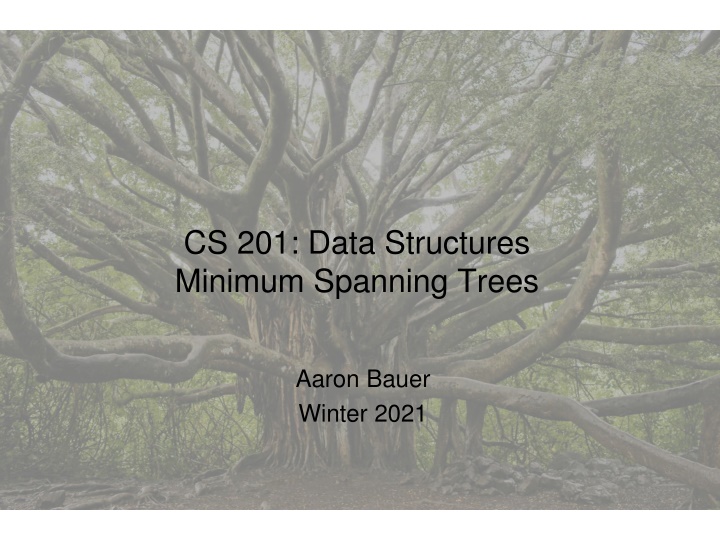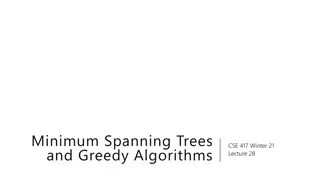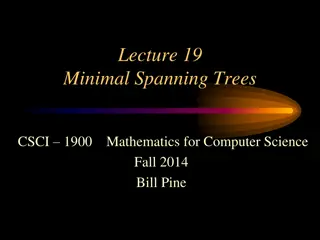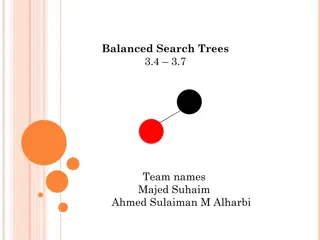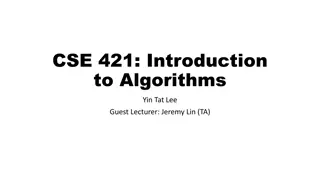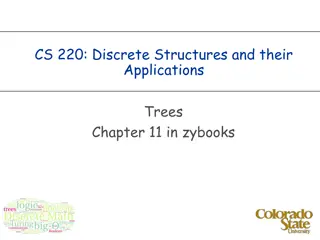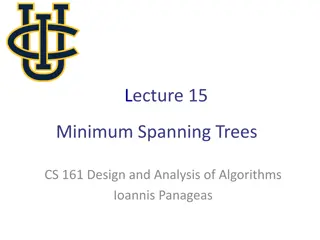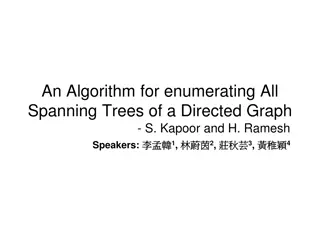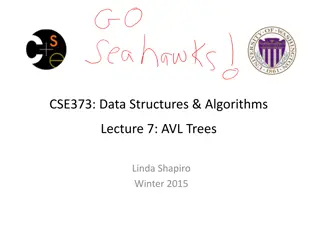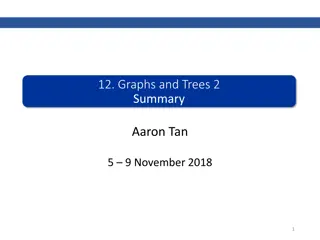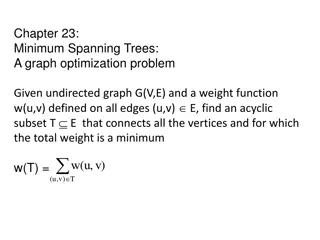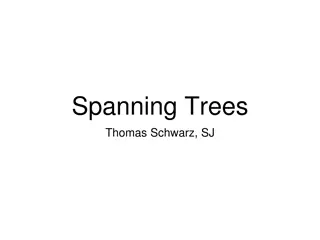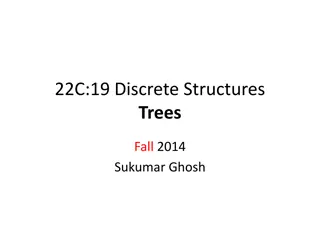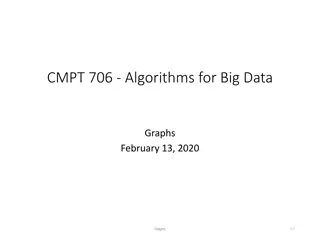Minimum Spanning Trees in Data Structures
Delve into the concept of minimum spanning trees in graphs, exploring their properties, applications, and algorithmic approaches. Learn how these trees efficiently connect nodes while minimizing edge costs.
Download Presentation

Please find below an Image/Link to download the presentation.
The content on the website is provided AS IS for your information and personal use only. It may not be sold, licensed, or shared on other websites without obtaining consent from the author.If you encounter any issues during the download, it is possible that the publisher has removed the file from their server.
You are allowed to download the files provided on this website for personal or commercial use, subject to the condition that they are used lawfully. All files are the property of their respective owners.
The content on the website is provided AS IS for your information and personal use only. It may not be sold, licensed, or shared on other websites without obtaining consent from the author.
E N D
Presentation Transcript
CS 201: Data Structures Minimum Spanning Trees Aaron Bauer Winter 2021
Spanning Trees A simple problem: Given a connected undirected graph G=(V,E), find a minimal subset of edges such that G is still connected A graph G2=(V,E2) such that G2 is connected and removing any edge from E2 makes G2 disconnected Winter 2021 CS 201: Data Structures 2
Observations 1. Any solution to this problem is a tree Recall a tree does not need a root; just means acyclic For any cycle, could remove an edge and still be connected 2. Solution not unique unless original graph was already a tree 3. Problem ill-defined if original graph not connected So |E| |V|-1 4. A tree with |V| nodes has |V|-1 edges So every solution to the spanning tree problem has |V|-1 edges Winter 2021 CS 201: Data Structures 3
Motivation A spanning tree connects all the nodes with as few edges as possible Example: want there to be ice-free paths between any two campus buildings what is the minimum set of paved walks that need to be de-iced? In most compelling uses, we have a weighted undirected graph and we want a tree of least total cost Example: Electrical wiring for a house or wires on a computer chip Example: A road network if you cared about asphalt cost rather than travel time This is the minimum spanning tree problem Will do that next, after intuition from the simpler case Winter 2021 CS 201: Data Structures 4
Two Approaches Different algorithmic approaches to the spanning-tree problem: 1. Do a graph traversal (e.g., depth-first search, but any traversal will do), keeping track of edges that form a tree 2. Iterate through edges; add to output any edge that does not create a cycle Winter 2021 CS 201: Data Structures 5
Spanning tree via DFS spanning_tree(Graph G) { for each node i: i.marked = false for some node i: f(i) } f(Node i) { i.marked = true for each j adjacent to i: if(!j.marked) { add(i,j) to output f(j) // DFS } } Correctness: DFS reaches each node. We add one edge to connect it to the already visited nodes. Order affects result, not correctness. Time: O(|E|) Winter 2021 CS 201: Data Structures 6
Example Stack f(1) top of stack 2 1 3 7 4 6 5 Output: Winter 2021 CS 201: Data Structures 7
Example Stack f(1) f(2) top 2 1 3 7 4 6 5 Output: (1,2) Winter 2021 CS 201: Data Structures 8
Example Stack f(1) f(2) f(7) top 2 1 3 7 4 6 5 Output: (1,2), (2,7) Winter 2021 CS 201: Data Structures 9
Example Stack f(1) f(2) f(7) f(5) top 2 1 3 7 4 6 5 Output: (1,2), (2,7), (7,5) Winter 2021 CS 201: Data Structures 10
Example Stack f(1) f(2) f(7) f(5) f(4) top 2 1 3 7 4 6 5 Output: (1,2), (2,7), (7,5), (5,4) Winter 2021 CS 201: Data Structures 11
Example Stack f(1) f(2) f(7) f(5) f(4) f(3) top 2 1 3 7 4 6 5 Output: (1,2), (2,7), (7,5), (5,4),(4,3) Winter 2021 CS 201: Data Structures 12
Example Stack f(1) f(2) f(7) f(5) f(4) f(6) f(3) 2 1 3 7 4 6 5 Output: (1,2), (2,7), (7,5), (5,4), (4,3), (5,6) Winter 2021 CS 201: Data Structures 13
Example Stack f(1) f(2) f(7) f(5) f(4) f(6) f(3) 2 1 3 7 4 6 5 Output: (1,2), (2,7), (7,5), (5,4), (4,3), (5,6) Winter 2021 CS 201: Data Structures 14
Second Approach Iterate through edges; output any edge that does not create a cycle Correctness (hand-wavy): Goal is to build an acyclic connected graph When we add an edge, it adds a vertex to the tree Else it would have created a cycle The graph is connected, so we reach all vertices Efficiency: Depends on how quickly you can detect cycles Reconsider after the example Winter 2021 CS 201: Data Structures 15
Example Edges in some arbitrary order: (1,2), (3,4), (5,6), (5,7),(1,5), (1,6), (2,7), (2,3), (4,5), (4,7) 2 1 3 7 4 6 5 Output: Winter 2021 CS 201: Data Structures 16
Example Edges in some arbitrary order: (1,2), (3,4), (5,6), (5,7),(1,5), (1,6), (2,7), (2,3), (4,5), (4,7) 2 1 3 7 4 6 5 Output: (1,2) Winter 2021 CS 201: Data Structures 17
Example Edges in some arbitrary order: (1,2), (3,4), (5,6), (5,7),(1,5), (1,6), (2,7), (2,3), (4,5), (4,7) 2 1 3 7 4 6 5 Output: (1,2), (3,4) Winter 2021 CS 201: Data Structures 18
Example Edges in some arbitrary order: (1,2), (3,4), (5,6), (5,7),(1,5), (1,6), (2,7), (2,3), (4,5), (4,7) 2 1 3 7 4 6 5 Output: (1,2), (3,4), (5,6), Winter 2021 CS 201: Data Structures 19
Example Edges in some arbitrary order: (1,2), (3,4), (5,6), (5,7),(1,5), (1,6), (2,7), (2,3), (4,5), (4,7) 2 1 3 7 4 6 5 Output: (1,2), (3,4), (5,6), (5,7) Winter 2021 CS 201: Data Structures 20
Example Edges in some arbitrary order: (1,2), (3,4), (5,6), (5,7), (1,5), (1,6), (2,7), (2,3), (4,5), (4,7) 2 1 3 7 4 6 5 Output: (1,2), (3,4), (5,6), (5,7), (1,5) Winter 2021 CS 201: Data Structures 21
Example Edges in some arbitrary order: (1,2), (3,4), (5,6), (5,7), (1,5), (1,6), (2,7), (2,3), (4,5), (4,7) 2 1 3 7 4 6 5 Output: (1,2), (3,4), (5,6), (5,7), (1,5) Winter 2021 CS 201: Data Structures 22
Example Edges in some arbitrary order: (1,2), (3,4), (5,6), (5,7), (1,5), (1,6), (2,7), (2,3), (4,5), (4,7) 2 1 3 7 4 6 5 Output: (1,2), (3,4), (5,6), (5,7), (1,5) Winter 2021 CS 201: Data Structures 23
Example Edges in some arbitrary order: (1,2), (3,4), (5,6), (5,7), (1,5), (1,6), (2,7), (2,3), (4,5), (4,7) 2 1 3 7 4 6 Can stop once we have |V|-1 edges 5 Output: (1,2), (3,4), (5,6), (5,7), (1,5), (2,3) Winter 2021 CS 201: Data Structures 24
Cycle Detection To decide if an edge could form a cycle is O(|V|) because we may need to traverse all edges already in the output So overall algorithm would be O(|V||E|) But there is a faster way we know: a data structure called union- find! All we need to know is that it efficiently keeps track of which elements are connected (can check for cycle in about O(1)) All elements start out disconnected union(int a, int b) connects a and b (like an edge in a graph) connectedTo(int a, int b) returns whether a and b are connected (again like a graph, could be a x y b) Read Algorithms 1.5 for the details Winter 2021 CS 201: Data Structures 25
Summary So Far The spanning-tree problem Add nodes to partial tree approach is O(|E|) Add acyclic edges approach is almostO(|E|) Using union-find as a black box But really want to solve the minimum-spanning-tree problem Given a weighted undirected graph, give a spanning tree of minimum weight Same two approaches will work with minor modifications Both will be O(|E|log|V|) Winter 2021 CS 201: Data Structures 26
Getting to the Point Algorithm #1 Shortest-path is to Dijkstra s Algorithm as Minimum Spanning Tree is to Prim s Algorithm (Both based on expanding cloud of known vertices, basically using a priority queue instead of a DFS stack) Algorithm #2 Kruskal s Algorithm for Minimum Spanning Tree is Exactly our 2nd approach to spanning tree but process edges in cost order Winter 2021 CS 201: Data Structures 27
Prims Algorithm Idea Idea: Grow a tree by adding an edge from the known vertices to the unknown vertices. Pick the edge with the smallest weight that connects known to unknown. Recall Dijkstra picked edge with closest known distance to source That is not what we want here Otherwise identical (!) Winter 2021 CS 201: Data Structures 28
The Algorithm For each node v, set v.cost = andv.known = false Choose any node v a) Mark v as known b) For each edge (v,u) with weight w, set u.cost=w and u.prev=v While there are unknown nodes in the graph a) Select the unknown node v with lowest cost b) Mark v as known and add (v, v.prev) to output c) For each edge (v,u) with weight w, if(w < u.cost) { u.cost = w; u.prev = v; } 1. 2. 3. Winter 2021 CS 201: Data Structures 29
Example 2 B A 1 1 5 2 E 1 D 1 3 5 C 6 G vertex A B C D E F G known? cost ?? ?? ?? ?? ?? ?? ?? prev 2 10 F Winter 2021 CS 201: Data Structures 30
Example 2 0 2 B A 1 1 5 2 E 1 1 D 1 3 5 C 2 6 G vertex A B C D E F G known? Y cost 0 2 2 1 ?? ?? ?? prev 2 10 F A A A Winter 2021 CS 201: Data Structures 31
Example 2 0 2 B A 1 1 1 5 2 E 1 1 D 1 3 5 C 2 5 6 G vertex A B C D E F G known? Y cost 0 2 1 1 1 6 5 prev 2 6 10 F A D A D D D Y Winter 2021 CS 201: Data Structures 32
Example 2 0 2 B A 1 1 1 5 2 E 1 1 D 1 3 5 C 2 5 6 G vertex A B C D E F G known? Y cost 0 2 1 1 1 2 5 prev 2 2 10 F A D A D C D Y Y Winter 2021 CS 201: Data Structures 33
Example 1 0 2 B A 1 1 1 5 2 E 1 1 D 1 3 5 C 2 3 6 G vertex A B C D E F G known? Y cost 0 1 1 1 1 2 3 prev 2 2 10 F E D A D C E Y Y Y Winter 2021 CS 201: Data Structures 34
Example 1 0 2 B A 1 1 1 5 2 E 1 1 D 1 3 5 C 2 3 6 G vertex A B C D E F G known? Y Y Y Y Y cost 0 1 1 1 1 2 3 prev 2 2 10 F E D A D C E Winter 2021 CS 201: Data Structures 35
Example 1 0 2 B A 1 1 1 5 2 E 1 1 D 1 3 5 C 2 3 6 G vertex A B C D E F G known? Y Y Y Y Y Y cost 0 1 1 1 1 2 3 prev 2 2 10 F E D A D C E Winter 2021 CS 201: Data Structures 36
Example 1 0 2 B A 1 1 1 5 2 E 1 1 D 1 3 5 C 2 3 6 G vertex A B C D E F G known? Y Y Y Y Y Y Y cost 0 1 1 1 1 2 3 prev 2 2 10 F E D A D C E Winter 2021 CS 201: Data Structures 37
Analysis Run-time Same as Dijkstra O(|E|log|V|) using a priority queue Costs/priorities are just edge-costs, not path-costs Winter 2021 CS 201: Data Structures 38
Kruskals Algorithm Idea: Grow a forest out of edges that do not grow a cycle, just like for the spanning tree problem. But now consider the edges in order by weight So: Sort edges: O(|E|log |E|) Iterate through edges using union-find for cycle detection almost O(|E|) Somewhat better: Floyd s algorithm to build min-heap with edges O(|E|) Iterate through edges using union-find for cycle detection and deleteMin to get next edge O(|E|log|E|) Not better worst-case asymptotically, but often stop long before considering all edges Winter 2021 CS 201: Data Structures 39
Pseudocode 1. 2. 3. Sort edges by weight (better: put in min-heap) Union-find has each node disconnected While output size <|V|-1 Consider next smallest edge (u,v) if connectedTo(u,v) indicate u and v are disconnected output (u,v) union(u,v) Recall invariant: u and v in connected in union-find if and only if connected in output-so-far Winter 2021 CS 201: Data Structures 40
Example 2 Edges in sorted order: 1: (A,D), (C,D), (B,E), (D,E) 2: (A,B), (C,F), (A,C) 3: (E,G) 5: (D,G), (B,D) 6: (D,F) 10: (F,G) B A 1 1 5 2 E 1 D 1 3 5 C 6 G 2 10 F Output: Winter 2021 CS 201: Data Structures 41
Example 2 Edges in sorted order: 1: (A,D), (C,D), (B,E), (D,E) 2: (A,B), (C,F), (A,C) 3: (E,G) 5: (D,G), (B,D) 6: (D,F) 10: (F,G) B A 1 1 5 2 E 1 D 1 3 5 C 6 G 2 10 F Output: (A,D) Winter 2021 CS 201: Data Structures 42
Example 2 Edges in sorted order: 1: (A,D), (C,D), (B,E), (D,E) 2: (A,B), (C,F), (A,C) 3: (E,G) 5: (D,G), (B,D) 6: (D,F) 10: (F,G) B A 1 1 5 2 E 1 D 1 3 5 C 6 G 2 10 F Output: (A,D), (C,D) Winter 2021 CS 201: Data Structures 43
Example 2 Edges in sorted order: 1: (A,D), (C,D), (B,E), (D,E) 2: (A,B), (C,F), (A,C) 3: (E,G) 5: (D,G), (B,D) 6: (D,F) 10: (F,G) B A 1 1 5 2 E 1 D 1 3 5 C 6 G 2 10 F Output: (A,D), (C,D), (B,E) Winter 2021 CS 201: Data Structures 44
Example 2 Edges in sorted order: 1: (A,D), (C,D), (B,E), (D,E) 2: (A,B), (C,F), (A,C) 3: (E,G) 5: (D,G), (B,D) 6: (D,F) 10: (F,G) B A 1 1 5 2 E 1 D 1 3 5 C 6 G 2 10 F Output: (A,D), (C,D), (B,E), (D,E) Winter 2021 CS 201: Data Structures 45
Example 2 Edges in sorted order: 1: (A,D), (C,D), (B,E), (D,E) 2: (A,B), (C,F), (A,C) 3: (E,G) 5: (D,G), (B,D) 6: (D,F) 10: (F,G) B A 1 1 5 2 E 1 D 1 3 5 C 6 G 2 10 F Output: (A,D), (C,D), (B,E), (D,E) Winter 2021 CS 201: Data Structures 46
Example 2 Edges in sorted order: 1: (A,D), (C,D), (B,E), (D,E) 2: (A,B), (C,F), (A,C) 3: (E,G) 5: (D,G), (B,D) 6: (D,F) 10: (F,G) B A 1 1 5 2 E 1 D 1 3 5 C 6 G 2 10 F Output: (A,D), (C,D), (B,E), (D,E), (C,F) Winter 2021 CS 201: Data Structures 47
Example 2 Edges in sorted order: 1: (A,D), (C,D), (B,E), (D,E) 2: (A,B), (C,F), (A,C) 3: (E,G) 5: (D,G), (B,D) 6: (D,F) 10: (F,G) B A 1 1 5 2 E 1 D 1 3 5 C 6 G 2 10 F Output: (A,D), (C,D), (B,E), (D,E), (C,F) Winter 2021 CS 201: Data Structures 48
Example 2 Edges in sorted order: 1: (A,D), (C,D), (B,E), (D,E) 2: (A,B), (C,F), (A,C) 3: (E,G) 5: (D,G), (B,D) 6: (D,F) 10: (F,G) B A 1 1 5 2 E 1 D 1 3 5 C 6 G 2 10 F Output: (A,D), (C,D), (B,E), (D,E), (C,F), (E,G) Winter 2021 CS 201: Data Structures 49
